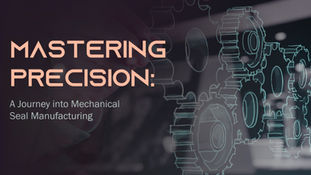
Investigating Seal Failure: Reasons, Indicators, and Preventive Actions for Mechanical Seals
Aug 6
3 min read
0
2
0
Introduction
Mechanical seals are essential components in industrial machinery, serving as the frontline defense against fluid leakage in rotating equipment. While these seals are designed for durability and reliability, seal failure can occur, leading to operational disruptions and potential damage. Let's explore the common causes, signs, and preventive measures associated with mechanical seal failure.

1. Causes Of Seal Failure:
Abrasive Wear: Abrasive particles in the fluid can lead to wear on seal faces over time, compromising the integrity of the seal. Cavitation: Rapid changes in pressure, known as cavitation, can create bubbles that implode, causing damage to seal surfaces. Corrosion: Exposure to corrosive fluids can degrade seal materials, leading to reduced performance and eventual failure. Improper Installation: Incorrect installation practices, such as misalignment or inadequate lubrication during assembly, can contribute to seal failure. Excessive Heat: High temperatures can affect seal materials, leading to distortion, reduced lubrication, and accelerated wear. Pressure Fluctuations: Frequent variations in pressure levels can impact the seal's ability to maintain a consistent barrier, leading to leaks.
2. Signs Of Seal Failure:
Fluid Leakage: The most obvious sign of seal failure is fluid leakage around the seal area. Increased Temperature: Seal failure can result in elevated temperatures due to increased friction and reduced lubrication. Vibration and Noise: Unusual vibrations or noise during equipment operation may indicate seal misalignment or wear. Reduced Efficiency: A decline in equipment performance, such as decreased pump flow or compressor output, can be a sign of seal issues. Visual Wear and Tear: Inspection of the seal surfaces may reveal visible signs of wear, corrosion, or damage.
3. Preventive Measures:
Proper Installation: Ensure that seals are installed correctly, following manufacturer guidelines and utilizing proper tools and equipment. Material Selection: Choose seal materials that are compatible with the fluid and environmental conditions of the application. Regular Maintenance: Implement a proactive maintenance schedule, including regular inspections, lubrication checks, and monitoring of seal performance. Condition Monitoring: Utilize advanced technologies, such as vibration analysis and temperature sensors, to monitor the condition of mechanical seals in real-time. Upgraded Designs: Consider upgrading to advanced seal designs that incorporate features like dual containment or enhanced materials for better resistance to wear and corrosion. Training and Education: Provide training to personnel involved in the installation and maintenance of mechanical seals to ensure best practices are followed.
4.Failure Analysis:
In the event of seal failure, conducting a thorough failure analysis is crucial. This involves examining the failed seals to identify the root causes, whether it be abrasive wear, corrosion, or other factors. This analysis provides valuable insights for implementing corrective actions and preventing similar failures in the future.
5. Collaborative Approach:
Effective seal management often requires collaboration between equipment operators, maintenance teams, and seal manufacturers. By sharing information on operating conditions, fluid characteristics, and equipment requirements, a collaborative approach can lead to the selection of optimal seal Solutions and proactive maintenance strategies. In conclusion, understanding the causes, signs, and preventive measures associated with mechanical seal failure is essential for maintaining the reliability and longevity of industrial equipment. By adopting best practices in installation, selecting appropriate materials, implementing regular maintenance, and leveraging advanced monitoring technologies, industries can minimize the risk of seal failure and ensure the uninterrupted operation of critical machinery.
Conclusion:
In conclusion, understanding the causes, signs, and preventive measures associated with mechanical seal failure is essential for maintaining the reliability and longevity of industrial equipment. By adopting best practices in installation, selecting appropriate materials, implementing regular maintenance, and leveraging advanced monitoring technologies, industries can minimize the risk of seal failure and ensure the uninterrupted operation of critical machinery.






